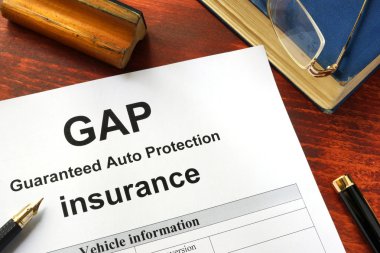What is GAP Insurance A 99 Comprehensive Guide | How Does It Work?
GAP insurance, which stands for Guaranteed Asset Protection insurance, is a type of insurance coverage that provides financial protection for individuals who finance or lease a vehicle. The purpose of GAP insurance is to cover the “gap” between the amount owed on a car loan or lease and the actual cash value of the vehicle in the event of a total loss, such as theft or an accident.

Table of Contents
What is Gap Insurance?
Gap Insurance, also known as Guaranteed Asset Protection Insurance, is designed to bridge the “gap” between what you owe on your car and its actual cash value in the event of a total loss. While your auto insurance policy may cover the current market value of your vehicle, it may not cover the remaining balance of your loan or lease. Gap Insurance fills this void, providing financial protection when you need it the most.
Gap Insurance, short for Guaranteed Asset Protection, is a unique insurance product designed to cover the “gap” between the actual cash value (ACV) of a vehicle and the amount owed on an auto loan or lease. This gap arises due to the rapid depreciation of a vehicle’s value the moment it leaves the dealership. Standard auto insurance policies typically cover the ACV, leaving the vehicle owner responsible for the remaining balance in case of a total loss.
In the vast landscape of insurance, there exists a little-known yet crucial player that often goes unnoticed until it’s needed the most—Gap Insurance. As we navigate the complex world of auto insurance, understanding the significance of Gap Insurance becomes paramount. This article aims to demystify the concept, unravel its intricacies, and shed light on why it might be the missing link in your insurance coverage puzzle.
Understanding Depreciation
To comprehend the need for Gap Insurance, it’s essential to grasp the concept of depreciation. From the moment you drive your shiny new car off the lot, its value starts to plummet. Depreciation is the decrease in the vehicle’s value over time, and it can be particularly steep in the first few years of ownership. In the unfortunate event of an accident, theft, or total loss, your auto insurance provider will reimburse you based on The existing market valuation of the vehicle—commonly considerably lower than the remaining balance on your loan or lease.
The Gap Insurance Shield
This is where Gap Insurance steps in as the unsung hero. Let’s consider a scenario: You’ve purchased a brand-new car for $30,000, and a year later, it’s involved in a serious accident. The insurance company determines the ACV at $22,000, leaving you with a $8,000 gap between the insurance payout and the remaining balance on your loan or lease. Without Gap Insurance, this financial burden falls squarely on your shoulders.
However, if you have Gap Insurance, it covers the $8,000 difference, ensuring that you’re not left with a hefty bill for a vehicle you no longer possess. This invaluable coverage can be a financial lifesaver, especially for those who finance their vehicles with low down payments or opt for extended loan terms.
Who Needs Gap Insurance?
While Gap Insurance offers a crucial safety net, it may not be necessary for everyone. Determining whether you need Gap Insurance depends on various factors, including the vehicle’s depreciation rate, your down payment, the length of your loan or lease, and your overall financial situation.
- New Car Buyers: Gap Insurance is highly recommended for individuals purchasing brand-new vehicles, as these vehicles experience the steepest depreciation in their early years.
- Leaseholders: If you’re leasing a vehicle, Gap Insurance is often included in the lease agreement. However, it’s essential to confirm this with your leasing company and understand the terms.
- Long-Term Loans: If you’ve opted for a loan with a duration of five years or more, the risk of owing more than the vehicle’s ACV is higher, making Gap Insurance a sensible choice.
- Low Down Payments: A minimal down payment means you’re financing a larger portion of the vehicle’s value. In the event of a total loss, this increases the likelihood of a significant gap between the insurance payout and your remaining balance.
How Does Gap Insurance Work?
To understand how Gap Insurance works, let’s consider a hypothetical scenario. Imagine you recently purchased a brand new car worth $30,000 and financed it with a loan. A few months down the line, unfortunately, your car is stolen or totaled in an accident. While your comprehensive or collision insurance may cover the actual cash value of your car, it might fall short of the outstanding balance on your loan.
This is where Gap Insurance steps in. If you have Gap Insurance, it will cover the difference between your car’s actual cash value and the amount you still owe on your loan or lease. In our example, if the actual cash value of your car is determined to be $25,000, but you still owe $28,000 on your loan, Gap Insurance will bridge the $3,000 gap, ensuring you are not left with a financial burden.
Total Loss Scenario
The primary function of Gap Insurance comes into play when your vehicle is declared a total loss. In such scenarios, standard auto insurance policies typically reimburse you for the current market value of the car, which may be significantly lower than what you owe on your loan or lease. Gap Insurance steps in to cover this difference, ensuring that you are not left with the financial burden of paying off a vehicle you no longer possess.
Loan or Lease Balance Coverage
Gap Insurance specifically targets the outstanding balance on your auto loan or lease. While your standard insurance may cover the ACV, Gap Insurance steps up to cover the remaining balance, safeguarding you from potential financial setbacks.
Early Stages of Ownership
Gap Insurance is particularly beneficial during the early stages of vehicle ownership when depreciation is most rapid. New cars often experience a substantial drop in value within the first few years, making Gap Insurance a valuable asset for those who recently purchased a vehicle.
Lease Agreements
For individuals leasing a vehicle, Gap Insurance is often included as part of the lease agreement. It ensures that in the event of a total loss, the lessee is not responsible for the difference between the insurance payout and the remaining lease balance.
Flexible Payment Options
Gap Insurance typically offers flexibility in payment options. Policyholders can choose to pay for the coverage upfront or include it as part of their monthly car payments. This flexibility makes Gap Insurance accessible to a wide range of vehicle owners.
Coverage Limits and Deductibles
It’s crucial to understand the coverage limits of your Gap Insurance policy. Some policies may have a maximum amount they will cover, and others may not cover your deductible. Clarifying these details ensures that you have a comprehensive understanding of the protection Gap Insurance provides.
Notable Considerations
While Gap Insurance is a valuable addition to your insurance portfolio, it may not be necessary for everyone. Factors such as a substantial down payment, short loan terms, or a vehicle’s slower depreciation rate might mitigate the need for Gap Insurance. It’s essential to assess your specific situation and make an informed decision based on your financial and vehicle ownership profile.
Benefits of Gap Insurance
Protection Against Depreciation
Vehicles tend to depreciate rapidly, especially during the first few years of ownership. Gap Insurance safeguards you against this depreciation by covering the difference between your car’s value and the amount you owe, allowing you to avoid potential financial strain.
Peace of Mind
Knowing you have Gap Insurance can bring peace of mind, protecting you from the unexpected and providing a safety net in case of an unfortunate event. It ensures that you are not left with a hefty loan or lease balance to pay off, even if your car is deemed a total loss.
Affordability
Gap Insurance is often available at a reasonable cost, which can be included in your monthly car payment. Considering the potential financial risk, the peace of mind it provides is well worth the investment.
Is Gap Insurance Right for You?
While Gap Insurance can be a valuable addition to your auto insurance coverage, it may not be necessary for everyone. It is particularly beneficial for those who have a high loan or lease balance, financed with a small down payment, or those driving a vehicle that depreciates quickly. It is essential to assess your individual circumstances and consult with a knowledgeable insurance agent to determine if Gap Insurance is right for you.
Disclaimer: Understanding Gap Insurance is crucial to protect your investment and ensure you are financially secure in case of an unforeseen event. By bridging the gap between your car's actual cash value and the outstanding balance on your loan or lease, Gap Insurance provides peace of mind. Evaluate your situation, consult with professionals, and make an informed decision to safeguard your financial future. Remember, a small investment today can save you from significant financial burdens in the future.
Blue Cross Blue Shield Health Insur 99 Easy Guide
Health Insurance in the US A 100 Easy Guide
What Is Insurance Explained In 12 Easy Steps
For More Posts Click Here










